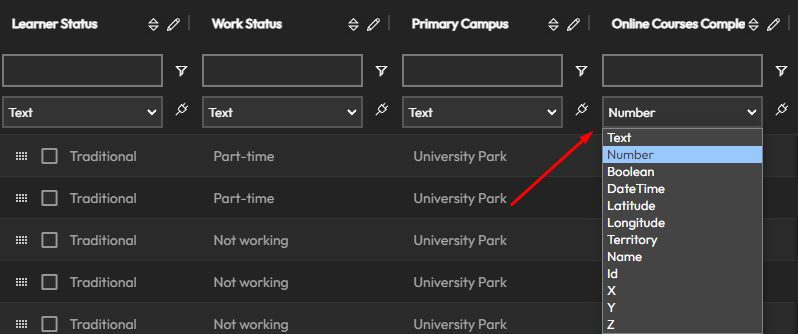Data Formats
Data formats help determine which data can be used in which visualizations and how. For example, map data contains coordinates and is classified as Spatial, while yearly sales data includes time values and is categorized as Temporal.
Users can easily determine format of their data from a UI tool we created: Data Format.
In this tool, users by looking their raw data, express its structure and assign dimensions to it and thus creating a Schema.

System than calculates which visualizations this data can be used on and how. It also summarizes its result to users through data tags.
These tags are determined according to schema. As we already mention, not all data can be used in every visualization. Some visualizations require specific data formats to make sense. Data tags help you identify your data format and indicate which visualizations can utilize that data format.
Note: On File Based Data Sources, Data format is already determined, so you do not have to specify data format, except for spreadsheet. In spreadsheet, you can assign a type for each column (dimension).

Summary of Data Tags:
- Dimensions:
- Desc: Number of Columns (Value Fields)
- Visualizations Require 2 or More: Boxplot, Candlestick, Chart3D, ParallelLine, ParallelScatter, ThemeRiver
- Visualizations Require 1 or More: Chart, Funnel, Geuge, Indicator, Pie, Polar, Radar, Timeline
- Temporal:
- Desc: Data with DateTime Values
- Visualizations: All Visualizations that support Animation
- Requires: DateTime
- Collection:
- Desc: Data in a Collection (Array or Dictionary)
- Visualizations: No visualization directly require Collection Tag, but they might have dimension requirements
- Requires: Collection
- Spatial:
- Desc: Geographical Data (GIS)
- Visualizations: Maps (Marker, Icon, Cluster and Heatmap Layers)
- Requires: Latitude and Longitude or Coordinate [lat,long]
- Identifier:
- Desc: Contains either Name or Id
- Visualizations: Maps (Tracking Layer)
- Requires: Name or Id
- Territorial:
- Desc: Choropleth Map Data
- Visualizations: Maps (Territory Layer)
- Requires: Territory (Country, city or region depending on scope)
- PointCloud:
- Desc: Lidar Data
- Visualizations: Lidar
- Requires: X, Y, Z
- Graph:
- Desc: Graph Data
- Visualizations: Graph, Sankey
- Requires: Nodes and Links (Edges)
- Tree:
- Desc: Tree Data
- Visualizations: Tree, Treemap, Sunburst
- Requires: Flat or Unflat Tree
- Sensor:
- Desc: Sensor Data
- Visualizations: Sensor
- Requires: Name and Reading
- Geojson:
- Desc: GeoJSON Data
- Visualizations: Maps (GeoJSON Layer)
- Requires: GeoJSON, KML Content Type, or GeoJSON Value
- Messages:
- Desc: Messages or Events
- Visualizations: Messages
- Requires: Name (Title) and Message (Description). Categories is optional. Categories can be a string for single category or string array for multiple category tags.